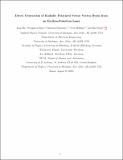Direct generation of radially polarized vector vortex beam with an exciton-polariton laser
Abstract
Vector vortex beams are a class of optical beams with singularities in their space-variant polarization. Vector vortex beam lasers have applications in many areas including imaging and communication, where vertical-cavity lasers emitting Gaussian beams have been most widely used so far. Generation of vector vortex beams from vertical-cavity lasers has required external control or modulation. Here, by utilizing a polarization-selective subwavelength grating as one of the reflectors in a vertical semiconductor microcavity, we design the spin textures of the polariton mode and demonstrate polariton lasing in a single-mode, radially polarized vector vortex beam. Polarization and phase distributions of the emission are characterized by polarization-resolved imaging and interferometry. This method of vector vortex laser beam generation allows low threshold power, stable single-mode operation, scalability, and on-chip integration, all of which are important for applications in imaging and communication.
Citation
Hu , J , Kim , S , Schneider , C , Höfling , S & Deng , H 2020 , ' Direct generation of radially polarized vector vortex beam with an exciton-polariton laser ' , Physical Review Applied , vol. 14 , no. 4 , 044001 . https://doi.org/10.1103/PhysRevApplied.14.044001
Publication
Physical Review Applied
Status
Peer reviewed
ISSN
2331-7019Type
Journal article
Description
Funding: J.H., S.K. and H.D. acknowledge financial support from the US Air Force Office of Scientific Research under grant FA9550-15-1-0240 and the US National Science Foundation (NSF) under grant DMR 1150593. The Würzburg group gratefully acknowledges support by the state of Bavaria.Collections
Items in the St Andrews Research Repository are protected by copyright, with all rights reserved, unless otherwise indicated.

